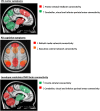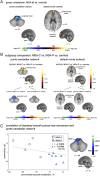Resting-state Functional MRI in Parkinsonian Syndromes
- PMID: 30838308
- PMCID: PMC6384182
- DOI: 10.1002/mdc3.12730
Resting-state Functional MRI in Parkinsonian Syndromes
Abstract
Background: Functional MRI (fMRI) has been widely used to study abnormal patterns of functional connectivity at rest in patients with movement disorders such as idiopathic Parkinson's disease (PD) and atypical parkinsonisms.
Methods: This manuscript provides an educational review of the current use of resting-state fMRI in the field of parkinsonian syndromes.
Results: Resting-state fMRI studies have improved the current knowledge about the mechanisms underlying motor and non-motor symptom development and progression in movement disorders. Even if its inclusion in clinical practice is still far away, resting-state fMRI has the potential to be a promising biomarker for early disease detection and prediction. It may also aid in differential diagnosis and monitoring brain responses to therapeutic agents and neurorehabilitation strategies in different movement disorders.
Conclusions: There is urgent need to identify and validate prodromal biomarkers in PD patients, to perform further studies assessing both overlapping and disease-specific fMRI abnormalities among parkinsonian syndromes, and to continue technical advances to fully realize the potential of fMRI as a tool to monitor the efficacy of chronic therapies.
Keywords: Parkinson's disease (PD); atypical parkinsonisms; functional MRI (fMRI); magnetic resonance imaging (MRI); resting‐state.
Figures




References
-
- Agosta F, Gatti R, Sarasso E, et al. Brain plasticity in Parkinson's disease with freezing of gait induced by action observation training. J Neurol 2017;264(1):88–101. - PubMed
-
- Lehericy S, Vaillancourt DE, Seppi K, et al. The role of high‐field magnetic resonance imaging in parkinsonian disorders: Pushing the boundaries forward. Mov Disord 2017;32(4):510–525. - PubMed
-
- Coleman P, Federoff H, Kurlan R. A focus on the synapse for neuroprotection in Alzheimer disease and other dementias. Neurology 2004;63(7):1155–1162. - PubMed
Publication types
LinkOut - more resources
Full Text Sources

